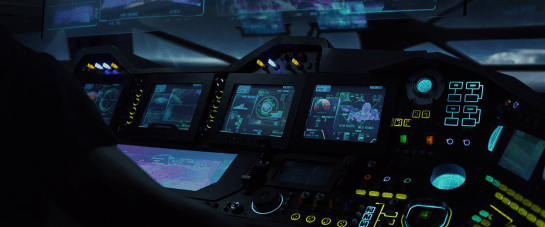After Hawkeye is enthralled by Loki, agent Coulson has to call agent Romanoff in from the field, mid-mission. While he awaits her to extract herself from a situation, he idly glances at case file 242-56 which consists of a large video of Barton and Romanoff mid-combat, and overview profiles of the two agents. A legend in the upper right identifies this as STRIKE TEAM: DELTA, and a label at the top reads ABIDJAN OPERATION. There is some animated fuigetry on the periphery of the video, and some other fuigetry in windows that are occluded by the case file. 
Tag Archives: nurnies
Glossary: Dunsels, Nurnies, Greebles, Gundans, and Fuidgets
No I am not randomly typing on the screen. I’m taking a pause from the Starship Troopers review to establish some much-needed vocabulary. Oftimes in science fiction, details are added to things for the sake of feeling more real, but that don’t actually do anything and, more importantly to our interests in scifinterfaces, aren’t even guided by a design philosophy. They’re the equivalent of “bullshit” in the H.G. Frankfurt sense. They don’t care about the diegetic truth of themselves, they only care about their effect.
Collectively, I call these things dunsels. But don’t thank me. Thank the midshipmen in the Star Trek TOS universe.
Dunsels appear in three major places in sci-fi.
The surface of objects: Nurnies and greebles
When they appear on spacecraft or futuristic architecture, they’re called greebles or, interchangably, nurnies. These terms come to us from the folks at ILM, who coined the term while developing the style for Star Wars.
I think I’d also apply these terms to props as well, that get covered by details that may not do anything or have much design logic behind them. That means weapons and gadgets, too.
The walls: Gundans
When this suface detailing is applied to sets, it’s called gundans. This after the Star Trek TOS pipes that got labeled “GNDN,” for “goes nowhere, does nothing.” Hat tip to Berm Lee for pointing me to this term.
Interfaces? Fuidgets
Not surprisingly, we need to have a word for the same sort of thing in screen interfaces, and I’ve never heard a word to describe them. (If a competitor’s already out there, speak up in the comments.) So after some nerdy social media talk amongst my Chief Nerds and Word People, my friend Magnus Torstensson of Unsworn Industries (and long time supporter of the scifiinterfaces project) suggested combining Mark Coleran‘s acronym “FUI” for “fictional user interfaces” and “widgets” to produce fuidgets, which is pronounced FWIDG-its. I love it. I’ll high-five you when I get to Malmö in November for Oredev, Magnus.
This neologism appropriately sounds as awkward as “nurnies,” “greebles,” and “gundans,” and simultaneously conveys their abstract, fantasy, digital nature. It’s a tough thing to wrap into a single word and I’m in awe that my Swedish friend beat me to it. 🙂
Using “fuidgets”
The spirit of apologetics (which is, perhaps, the core of this project) asks that you don’t dismiss details as H.G.Bullshit. You try as hard as you can to find sense in them. That way we don’t get caught up in a spiral of second-guessing an author’s intent, and moreover, that’s where some of the niftiest insights of this sort of analysis come from. But try though we might, sometimes there is just no explaining odd details that litter sci-fi displays, surfaces, and gadgets, other than to admit that they mean nothing and are there only to give a sense of truthiness. So, now we have that word. Fuidgets. You saw it in Monday’s posts, and I’m sure you’re going to see it again.





